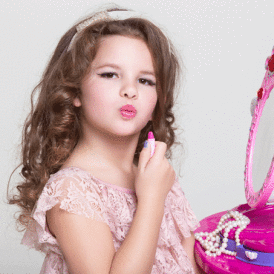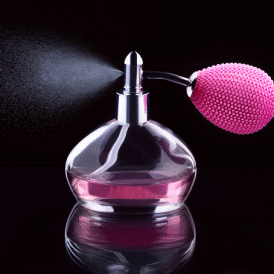I’ve visited Japan twice, and both times I was mesmerized by the seemingly effortless beauty Japanese women radiate. Their bodies are slim and fit, and their clothes fit so well they appear custom-made just for them. The great majority of ladies—even the women over 60—have flawless porcelain skin that appears lit from within. And their hair—don’t me started on their hair—is always smooth and frizz-free, even in the hottest, most humid weather.
Walking around Tokyo last summer in 99-degree weather, I had to wrestle my wavy hair into a ponytail or bun, or wear it under a hat to prevent that Don King look. And by midday, the little makeup I had on was melting into my face. But there they were, those Japanese girls, walking around the sweltering city in long pants, with their smooth, shiny hair hanging down their backs, not a lock or lash out of place. So one night at dinner, I asked my husband’s gorgeous cousin, who lives in Tokyo and works for a Japanese cosmetics company, what beauty secrets she and other Japanese women were hiding from us Americans.
What she (and other women I asked along the way, including cosmetics counter saleswomen and even my father-in-law’s cousin, a 60-something who looks 35) revealed: From as early as they can tie their shoes, Japanese women are taught to groom themselves. They choose their beauty products carefully, don’t overdo makeup, and use the simplest, most natural products available. That said, Japan is known for its cutting-age beauty supplies, from its top-notch eyelash curlers to its superior Q-tips (seriously, they’re finer, denser and sturdier than the American versions), so these ladies also have the best tools at their fingertips.
Here are top 10 cues we can take from Japanese women. Some might seem strange, but others might inspire you to think more like an Easterner when it comes to your beauty regimen.
1. They’re kind to their hair. Japanese women wash their hair infrequently and forgo the harsh alkaline shampoos that are so prevalent in the United States. Instead, they opt for products with natural ingredients like seaweed powder and camellia (tsubaki) oil, such as the best-selling shampoo and conditioner by Shiseido. Japanese ladies also groom their hair with tsubaki oil, combing it through their locks once a day to keep frizz at bay. They prefer wood combs, which don’t snag the hair or generate electricity, and whose microscopic pores help to redistribute oil in a thin, even layer, promoting natural shine.
2. They’re not afraid to use oil on their face. While many Americans are obsessed with “oil free” products, Japanese women embrace them. It sounds counterintuitive, but Japanese women know that cleansing the skin with oil can actually improve its texture and fight breakouts. The Japanese brand Shu Uemura was making oil cleansers decades before they became trendy in the United States, and DHC’s olive-oil-based Deep Cleansing Oil, which dissolves makeup and other impurities, is another top seller in Japan. Rice bran oil, which is rich in vitamin E and antioxidants, is another common ingredient in Japanese facial products.
3. They swear by facial blotting papers. A centuries-old Japanese beauty secret, blotting papers are used throughout the day by Japanese women to keep their faces shine free and preserve their makeup. Most come in little packets so they may be stored in a purse for on-the-go touch-ups. Oil-blotting papers by Kyoto cosmetics company Yojiya are legendary, while Tatcha’s all-natural leaflets are powder, pulp and fragrance free and absorb excess oil without disturbing makeup or robbing the skin of moisture.
4. They keep it light. Unlike some Americans, who still worship bronzed skin, Asian women avoid the sun entirely and work hard to retain their pure, untanned complexions. It’s hard to find a cosmetics counter in Japan that’s not touting at least one brightening product, such as Shiseido’s popular White Lucent cream. Antioxidants such as green tea are key ingredients, with natural components like seaweed, kelp and arbutin, an extract of the bearberry plant, helping to even out skin tone. Want an extreme brightener? Take a cue from Geishas to celebrities who swear by a product called Uguisu No Fun, a facial mask that contains sterilized nightingale droppings—yes, bird poop—which are said to purify and brighten. (Read about what other products can give you a youthful glow here.)
5. They exfoliate (and shave!) their faces. Smooth complexions are the hallmark of the Japanese woman’s beauty. They get it by exfoliating with gentle facial scrubs made of finely ground azuki beans or using washcloths with a special weave that wipes away trapped dirt using little or no soap. Many Japanese women opt for a water-based exfoliator, such as the best-selling Cure Natural Aqua Gel, which eliminates dead skin and impurities without scrubbing beads. Because light reflects better on hairless skin, Japanese ladies get themselves waxed, tweezed or lasered regularly. And they do regular touch-ups with tiny face razors that whittle away peach fuzz and stray hairs above the eyebrows.
6. They lash out regularly. You can’t walk a block in Tokyo without passing a salon specializing in eyelash extensions. They come in all lengths, thicknesses and colors and give Japanese girls a fun and flirty look for a special occasion. But prolonged use of extensions can eventually damage natural lashes. So for every day, Japanese women rely on falsies (read about how to apply them here), which are sold at every drug store and cosmetic shop in Tokyo. They also believe in quality eyelash curlers, such as the iconic one by Shu Uemura, and quality mascaras, including the popular Dejavu Fiberwig, that are infused with lengthening fibers and moisturizing agents. (Read our story about how you can use eye makeup to look more youthful.)
7. They make bath time a ritual. The Japanese love to bathe. They do it as an end-of-day ritual to help them relax for bedtime, but also to beautify the skin. Scrubbing the body from neck to toes with an exfoliating cleanser and a special brush is commonly done before climbing into a steaming hot bath, which is often infused with green tea, aromatic herbs, or fragrant and softening bath oils. The tannins in the tea help to tighten pores and retain moisture, while a Salux washcloth can further smooth and exfoliate the skin.
8. They avoid the sun entirely. While some of us Westerners barely remember to apply sunscreen before leaving the house, Japanese women go to great lengths to avoid the sun’s damaging rays. They carry parasols and wear hats on bright days, don long-sleeved shirts and pants even in warm weather, and protect their hands and arms with UV-coated gloves. When riding bicycles, some ladies even attach special hand covers to the steering wheel to protect their skin from the sun.
9. They have amazingly healthy diets. Sure, they indulge in ramen or American fast food once in a while, but for the most part Japanese women load up on all the healthy foods that compose the traditional Japanese diet. Their meals typically include lots of vitamin-packed “brassica” vegetables like broccoli and Brussels sprouts, as well as a great deal of fish, which is rich in skin-loving omega-3 fatty acids. Diet staples also include mushrooms, seaweeds and green tea, all of which contain powerful anti-aging antioxidants, as well as rice, a lowfat, complex carbohydrate. With all this good stuff going into their bodies, it’s no wonder their skin and hair radiate health.
10. They believe in the power of “unseen” beauty. Japanese women are known throughout the world for their feminine and graceful beauty. There is a Japanese concept called mie-nai osharé, which roughly translates to “unseen beauty,” or beauty that does not have to be displayed to be appreciated. When a Japanese lady dresses up (which she does routinely, even for everyday occasions), she will carefully pick not only the right outerwear, but also the most luxurious underthings – not for public display, but just for herself.
For dozens more sensational Japanese beauty products, visit Red Typewriter’s Pinterest Page.
























2014/06/11 at 1:54 pm
Great Tips! The Japanese also get their hair thinned which apparently does not have good results on European hair. Anyone of European decent who wants good hair while in Tokyo should get it done at a European salon. I went to Sin Den in Tokyo arranging the appointment before the trip via email after reading about many unhappy haircuts on trip advisor. Fabio, the owner, a handsome Italian man from the Amalfi coast, did wonders. Didn’t wash my hair the entire time and just touched it up after showers with the blowdryer. English, Japanese and Italian are spoken at the salon. It was well worth it having nice hair during a Tokyo heat wave with temperatures at 99 degrees farenheit every day with high humidity. My curly hair stayed straight! Sin Den prefers scheduled appointments and it was easy to schedule via email while I was in the states. Just Google…
Sin Den: A Wickedly Good Hair Salon in Tokyo
3-9-3 Jingumae, Shibuya-ku,
Tokyo 150-0001
TEL: 03-3405-4409
FAX: 03-3405-4408
2014/06/13 at 6:00 am
Awesome tips, Ann, thank you!
2014/10/25 at 8:10 am
Thanks!!, great article. I wish Sin Den would be closer to my home, Switzerland
2015/11/07 at 5:42 pm
Japanese women are gorgeous! We have a lot to learn from them. Great story.
2015/11/07 at 5:43 pm
While I wouldn’t try anything with bird poop in the ingredients, I think that Japanese products are far superior to anything made in America, although that may be changing now that trend are worldwide. I love blotting papers and all the cleansing oils and try to stock up on those overtime I visit Japan.
2016/05/24 at 7:27 pm
These are the things american women should be taught. When I look around and see american women and other groups also half dressed thinking they look appealing, if only they knew they are not appealing at all and far from being feminine. Time for women to open their eyes and realize they don’t have to pour the makeup on or take half their clothes off to be noticed
2017/10/08 at 4:42 pm
Thanks for sharing information, I am indeed looking for tips for beautiful Japanese people and I think I find the answer here. Nice Website :)